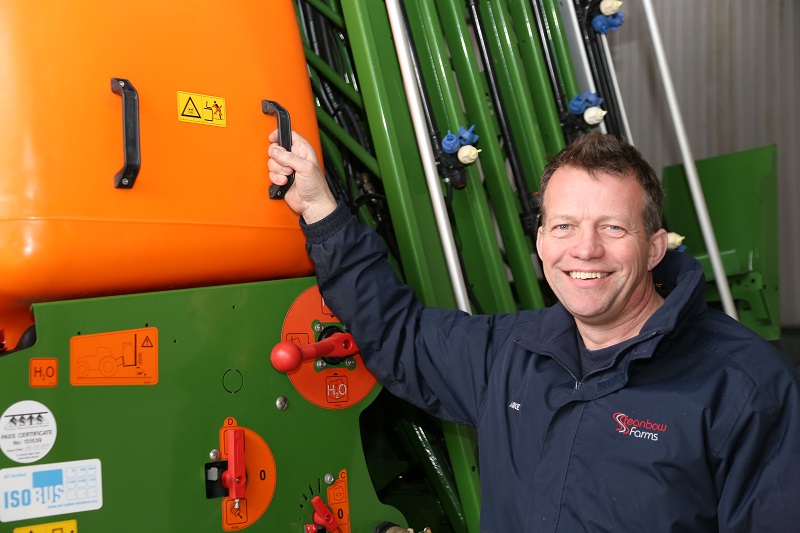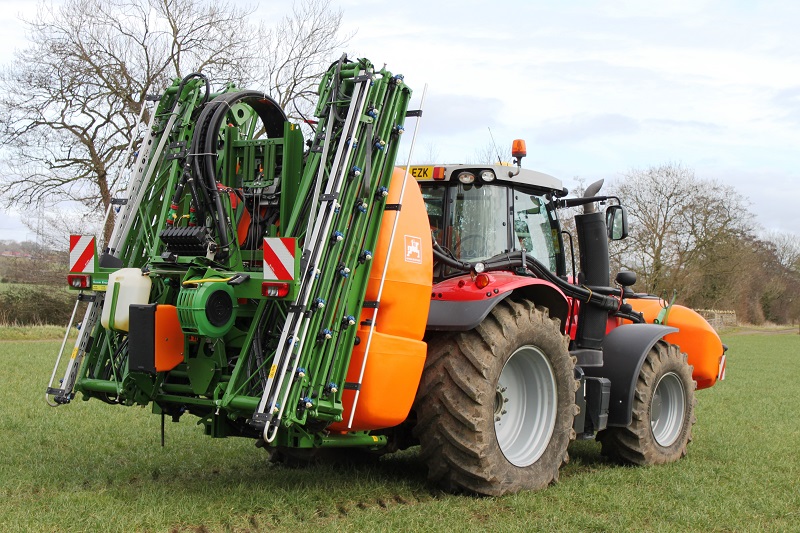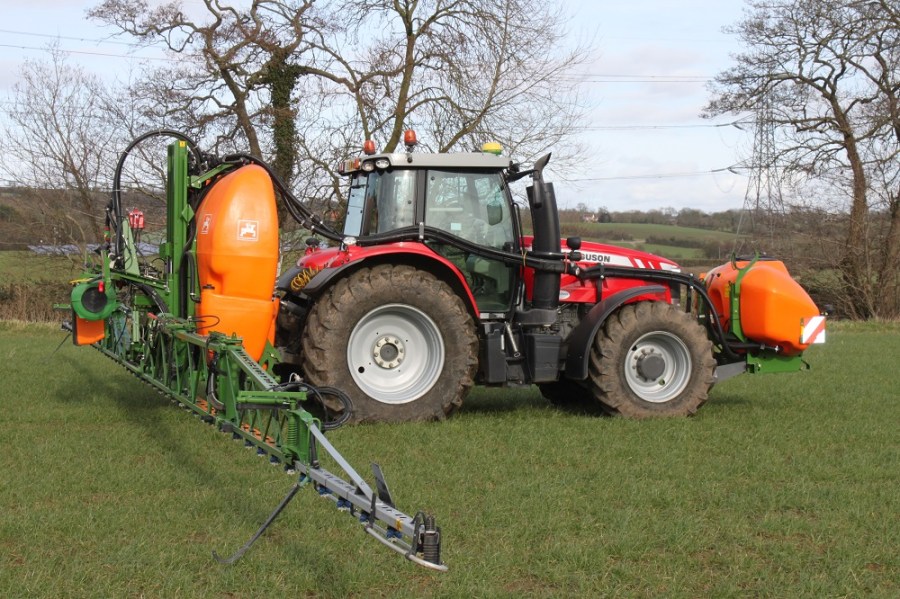When the farm that hosts the Glastonbury Festival in Somerset came to change its sprayer, it was time for new technology to take centre stage on the front and rear combination. CPM finds out how it performed.
A combination provides a much better balance, which improves traction in wetter conditions.
By Mick Roberts
It’s always best to plan machine purchases, rather than react to an unexpected breakdown. But when it comes to widening tramlines it’s vital the replacement sprayer is purchased in time for the new season.
So after making the decision to move up to 24m tramlines, Michael Christensen, from Steanbow Farms, Pilton near

Michael Christensen says the sprayer hasn’t only increased spraying capacity, but also efficiency and application accuracy.
Shepton Mallet, and sprayer operator, Alister Henson had time to investigate what they needed to take over from an 18-year-old Knight front and rear combination.
“The sprayer covers about 2800ha/year on our land plus some contracting. Going to 24m tramlines would improve efficiency with wider tramlines at home and, at the same time, conform with other local farms where the wider bout width is becoming more common,” says Michael Christensen.
Latest technology
“We also wanted to take advantage of the latest technology on the machine,” adds Alister Henson. “As well as extra capacity, we also felt we needed auto-section control, boom-height control and other automatic functions.” Michael Christensen concurs, adding that he also sees the benefit of improving accuracy, particularly how maintaining the boom at the correct height ensures more chemical goes into the crop and isn’t lost as drift. This is good for the farm and environment.

The 24m wide, rear-mounted booms can operate independently, are equipped with auto-levelling and fold to 2.4m wide for transport.
Although they were happy with the Knight, as well as its front and rear configuration, they did consider other options. A new self-propelled was, cost wise, out of the question and a used machine was quickly discounted, because neither owner nor operator could see the point of buying another, unnecessary power unit.
“The spraying tractor is a fairly new 175hp, Massey Fergusson 7618, which has a Dyna-VT (continuously variable transmission), ISOBUS terminal, nice cab and few self-propelleds can match its other specifications,” explains Alister Henson.
A trailed sprayer wasn’t considered suitable either, because there are some steep fields and some fairly heavy clay land on the farm. “When this gets wet it makes travelling difficult and that will only be made worse pulling a dead weight behind the tractor,” adds Michael Christensen.
“A combination provides a much better balance, with the front tank acting as ballast for the rear-mounted sprayer, spreading the load on the four-wheel drive tractor, which improves traction in wetter conditions.”
So the obvious answer was to keep with the tried and tested, tractor-mounted combination, particularly as technology has moved on so much since the last time they were in the sprayer market.
“We had an open mind, but we did have a ‘shopping list’ of essentials and nice to haves,” adds Alister Henson. This included: 24m wide boom, more capacity, auto-section control, boom height control and other affordable beneficial technology.
The pair looked at quite a few makes and models, including the serious consideration of a like-for-like Knight replacement. Eventually, however, they settled on an ex-demo Amazone UF 1801 with ISOBUS and FT 1001, front-mounted tank for a number of reasons.
Automatic filling
“Firstly we like the way control of the FT 1001 front tank can be integrated with the rear so the two tanks act as one when it comes to automatically filling and transferring the mixed liquid – at 200 litres/min. So I can treat the entire capacity as one mix – I don’t need to mix separate front- and rear tank loads,” explains Alister Henson. “Although the front tank can hold clean water or a different mix if required.
“The Amazone combination is also about 1t lighter than some equivalent sprayers, which is important. We did wonder if this was down to build quality, but we think it’s simply due to modern manufacturing techniques. Local dealer support was also important, and when Andy Miller from Mason Kings told us he had an ex-demo sprayer, with ISOBUS and the exact specification, including DistanceControl automatic boom height system we wanted, it was clearly the best option,” he explains.
The new sprayer comprises an Amazone rear-mounted 1920-litre capacity UF 1801 with 24m, Super-S boom, which has independent angling and folding for each side as well as rear folding to within 2.4m for transport.
While the rear-folding boom, which tucks in behind the sprayer, wasn’t initially on the shopping list, both operators now really appreciate the neat arrangement. Its narrow transport width, they say, is a real advantage when driving down lanes as well as on main roads.
Up front is the 1000-litre capacity FT 1001, with Flow Control. This also comes with an extra 100-litre clean-water tank, which slots into a special place for it on the rear tank and integrates into the washing circuit.
The sprayer set-up is normally mounted on a 175hp, MF 7618 Dyna-VT tractor with front linkage, with the ISOBUS-ready machine controlled through the tractor’s compatible Datatronic 4 terminal in the cab. “The connection to the sprayer was “literally plug‘n’play,” says Alister Henson. All the sprayer’s control is via the terminal’s screen, without the need for a dedicated unit, which saved about £1,500, he adds.
Although the tractor wasn’t auto-steer ready, the farm had an existing John Deere GreenStar 2630 terminal with auto-section control software and SF2 receiver. Alister Henson sourced the necessary steering valves and John Deere fitting kit and adapted this to mount to the Massey Ferguson.
ISOBUS link
Now the GreenStar terminal runs the steering and mapping as well as the auto-section control, linked via ISOBUS to the sprayer, while the tractor’s ISOBUS screen operates the sprayer, including the DistanceControl automatic boom-height system. They also opted for the ISOBUS joystick up in the cab. Both operators agree that this provides a steady control unit, which makes it much easier to operate the sprayer’s functions without trying to hit on-screen buttons.
Michael Christensen says he was quite nervous about using the technology on the sprayer, rather than the completely ‘manual’ predecessor. “But I quickly got to grips with how it works and was pleasantly surprised how I took to using it quite quickly and easily. We specced it with all this equipment and we’re using it all. I wouldn’t want to go back to manual section control and switch boxes.
“I think the DistanceControl automatic boom height system has been really useful. In my experience I find however much you try to keep the boom down to 50cm above the target in reality it’s always too high.
“Also we now have seven sections and, even though we were pretty accurate before, I think even with the wider boom that’ll only improve with the auto-section control,” he says.
Both operators are impressed with the automatic filling system, which is another option they wanted and was included on the ex-demo machine. “This treats both tanks as one and all I need to do is dial in the required amount – from 2800 litres down and the system fills whatever I require,” explains Alister Henson. “It just provides so much piece of mind when filling and allows me to concentrate on the mix, and not worry even if I’m interrupted.”
This is one element in Amazone’s Comfort Pack for ISOBUS terminals, which also includes automatic cleaning operated from the terminal. The cleaning cycle runs automatically, flushing the lines, tank and agitation system without having to leave the cab. It also controls the agitation, shutting it off when the tank contents are less than 5% of the volume.
Flow Control for the front tank automatically transfers the liquid using level sensors. This helps maintain the balance across the machine by moving liquid (at 200 l/min) only when the rear tank drops to a third full. This can also be carried out manually.
Capacity to expand
The machine’s workload comprises spraying mainly autumn-sown feed wheat, maize and grass, which are all consumed ‘in-house’ as forage for the 500-head dairy herd or as feed for the 540,000 broiler chicken unit. It’s also used on some stubble to stubble contract work as well as some one-off contracting and now provides the capacity to expand this area.
The ‘rotation’ also includes the Glastonbury festival, which each summer takes over more than 200ha of grassland. As any festival goer, or those who have seen it on the TV will know, this is sown on some quite heavy clay loams. Every five years there’s a break in the music and about 120ha is ploughed.
“The festival does present its own unique challenges, but otherwise the grass is just treated as a normal crop in the rotation,” says Alister Henson. “The biggest problem is metal – usually discarded or un-retrieved tent pegs. These could seriously damage machinery and contaminate the silage, so a 4m wide magnet is a very important part of the machinery fleet. This is operated very slowly using the auto-steer and mapping to make sure it’s all covered.”
First wheat, this year Panorama, is sown after the maize, with JB Diego favoured for the second wheat position. Mycotoxin risks following the maize are reduced by the plough, power-harrow establishment, which also provides a more weatherproof regime, explains Michael Christensen. All the wheat straw is baled and used in house, with cow slurry and chicken muck applications replenishing the soil’s organic matter.
Spraying starts with pre-em applications soon after drilling and rolling, although at the end of the season, after maize harvest, the weather can deteriorate quickly. Alister Henson prefers to use 035 Defy nozzles, angled forwards and back, with the 150 l/ha output providing, he feels, better coverage than lower rates.
Blackgrass isn’t a big problem, says Michael Christensen, and they always autumn plough the heavy land, hoping for a good frost heave. But they’re now looking closely at cover crops to control weeds and provide other soil benefits. Otherwise herbicide applications centre around pendimethalin-based products if appropriate and required.
Fungicides start at T0, says Alister Henson, because they tend to get good growth through the winter and the crop is at risk from the wetter climate. He can easily cover the whole wheat area in three days with the new sprayer, he adds.
Triple holders on the booms contain the Defy nozzles for early grass weed work, 03 standard flat fans as well as 03 GuardianAirs, which are used in less favourable conditions.




